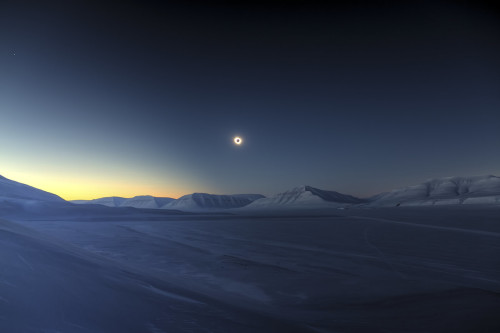
“Eclipse Totality over Sassendalen” by Luc Jamet.
(Courtesy: Luc Jamet/RAS)
By Michael Banks and Tushna Commissariat
It’s that time of the year again when the Royal Observatory Greenwich announces the winners of its Astronomy Photographer of the Year award and releases some of the most wonderful and awe-inspiring celestial images. Pictured above is this year’s overall winning image – titled “Eclipse Totality over Sassendalen” and taken by French photographer Luc Jamet, this stunning skyscape was taken from Svalbard during the total solar eclipse that took place earlier this year. “It is one of those heart-stoppingly beautiful shots for which you feel grateful to the photographer for sharing such an exceptional moment,” says Melanie Vandenbrouck, who was one of the judges. If you are in London, then you can drop in to the observatory to see the full exhibition , which opens today, and you can see all the winning images online.
While you’re admiring pictures, do take a look at the latest images of Pluto – backlit by the Sun and showing off its many rugged mountains and icy planes – taken by the New Horizons probe. The pictures are eerily similar to something you would see at the poles of our very own planet, while still maintaining its alien air.
By now, most of you will have heard about Ahmed Mohamed – the 14-year-old American school boy who was arrested over a home-made digital clock he built and brought in to school that some of his teachers took for a bomb. Although no charges were filed against him (the arrest was for possession of a “hoax bomb”), in the end, the incident and Mohamed’s treatment at the hands of authority figures has been deemed unfair and unnecessary. His case was quickly highlighted on social media as the hashtag #IStandWithAhmed took off on Twitter, along with a photo of the upset-looking teenager in handcuffs and sporting a NASA T-shirt. The discussion around Mohamed’s case has touched upon a variety of social issues including Islamaphobia, technophobia, school violence and over-reaction from the school.
A press-release issued by the police includes an image of the clock (which, like any DIY electronics project, contains a mess of wires and some circuitry), which the police still maintain looks like a “suspicious device”. To make sure that people don’t get confused again, we suggest that everyone does a little DIY electronics this weekend – take a look at this collection of videos over on the Wired website that show you how to build a digital clock. Mohamed, who has been thrust into a global spotlight over the past few days, has now been invited by Barack Obama to visit the White House and bring along his clock, not to mention open invites to NASA, Facebook and a host of other large tech companies, all of whom have shown their support.
Also this week, the Australian Academy of Science launched a pilot programme for the Athena SWAN Charter for Women in Science. Athena SWAN has been running for 10 years in the UK and offers bronze, silver and gold awards to institutions that eliminate gender inequality, demonstrate a commitment to bolstering the hiring, promotion and retention of women, as well as improve the workplace environment for all people. Some 32 institutions will participate in the pilot, which the Australian academy is hoping will improve gender equality in the country. You can read more about the project and how it came about over at the Sydney Morning Herald website, in this article by Nobel prize- winning physicist Brian Schmidt.
For some weekend fun, take a look at this video over on the iO9 website, which shows how particles in a coffee puddle resemble an avalanche, creating the well-known coffee-ring effect (skip ahead to 2:22 if you are impatient and just want to see the sped-up avalanche-like motion of the particles) and get your writing caps on and pen a fictional story full of quantum mechanics for this year’s Quantum Shorts flash-fiction competition.
To see a list of this category, just see http://www.researchgate.net
Trackback: Black-hole Sun, ticking clocks, coffee-stain avalanches and more – MyPhysNet